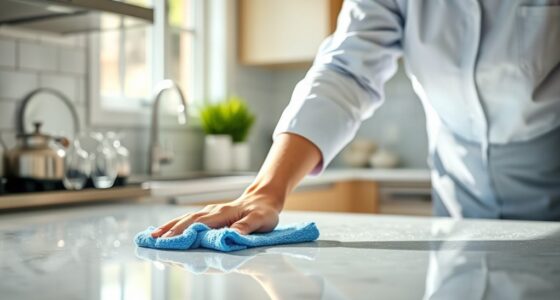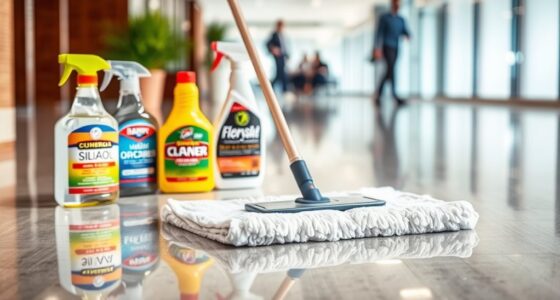To prevent germ spread during commercial cleaning, you must follow strict protocols. Use designated tools and cleaning cloths for specific areas, changing gloves frequently, and disinfecting tools after each use. Always clean from the least contaminated to the most contaminated surfaces. Proper hand hygiene and adhering to food safety guidelines also play key roles. By implementing these best practices, you can effectively reduce cross-contamination. Keep going to discover more ways to guarantee a safer, healthier environment.
Key Takeaways
- Use designated cleaning tools and cloths for specific zones to prevent cross-contact.
- Change gloves frequently and disinfect tools after each use to minimize germ transfer.
- Follow a systematic cleaning order, from least to most contaminated areas, to reduce cross-contamination risk.
- Properly train staff on hygiene protocols, emphasizing the importance of surface and tool management.
- Implement strict protocols and regular staff training to ensure consistent, effective germ prevention practices.

Have you ever wondered how easily germs can spread during commercial cleaning? It’s a common concern, especially when you consider how quickly bacteria and viruses can transfer from one surface to another. Cross-contamination isn’t just about dirt; it’s about germs traveling through improper cleaning practices, leading to health risks in workplaces, restaurants, and public spaces. That’s why understanding how to prevent this spread is essential, and a big part of it comes down to proper employee training and maintaining food safety standards. When staff members are well-trained, they learn how to handle cleaning tools, chemicals, and surfaces correctly, reducing the chance of transferring germs between areas. They know that cleaning cloths, mops, and brushes must be designated for specific zones—like food prep areas versus restroom facilities—to prevent cross-contamination. Training also emphasizes the importance of changing gloves frequently and disinfecting tools after each use, especially when moving between high-touch surfaces and food contact zones. This ensures germs don’t hitch a ride from contaminated spaces to cleaner ones.
Food safety is a crucial aspect in environments where food is prepared or served, and it directly ties into how thoroughly cleaning is approached. When employees understand the risks of cross-contamination, they become more diligent about following cleaning protocols designed to protect consumers. Proper training makes it clear that even small lapses—like using the same cloth on a bathroom sink and a food prep table—can have serious health consequences. This awareness fosters a culture of responsibility, prompting staff to stay vigilant and adhere strictly to hygiene standards. Additionally, trained employees know the importance of cleaning from the least contaminated areas to the most contaminated ones, ensuring that bacteria aren’t spread inadvertently. They also understand the significance of using appropriate cleaning agents and tools for different surfaces, which kills germs more effectively and minimizes the chance of transfer. Moreover, understanding the effectiveness of security measures in deterring theft can be compared to how proper cleaning protocols act as a safeguard against the spread of germs, emphasizing the importance of preventative practices in maintaining safety.
In essence, preventing cross-contamination during commercial cleaning depends on well-structured employee training programs. These programs teach staff the right techniques, emphasize the importance of food safety, and instill habits that keep germs at bay. When everyone on your team understands their role and follows best practices, the risk of spreading harmful bacteria decreases greatly. It’s about creating a clean environment where safety isn’t an afterthought but a fundamental part of the routine. Proper training makes all the difference, ensuring that your cleaning efforts protect health, uphold food safety standards, and prevent the spread of germs from one surface to another.
Frequently Asked Questions
How Often Should Cleaning Tools Be Sanitized to Prevent Cross-Contamination?
You should sanitize your cleaning tools frequently to prevent cross-contamination. Follow the recommended frequency guidelines for tool sterilization, which often means cleaning and disinfecting tools after each use on different surfaces or daily if used repeatedly on the same area. Regularly sterilizing your tools minimizes germs and bacteria spread. Make sure to use appropriate disinfectants and follow manufacturer instructions to guarantee effective sanitation and keep environments safe.
What Are the Latest Technologies Used to Minimize Germ Spread During Cleaning?
Imagine a cleaning process as a high-tech battle against germs. Today, UV sterilization uses ultraviolet light to instantly kill bacteria on surfaces, while AI-powered disinfecting systems analyze areas needing extra attention and adapt in real-time. These technologies are like smart warriors, ensuring thorough cleaning and minimizing germ spread. You benefit from faster, more effective sanitation, creating safer environments and reducing cross-contamination risks with cutting-edge tools.
How Do Cleaning Professionals Train Staff to Avoid Cross-Contamination?
You train staff to avoid cross-contamination by emphasizing staff hygiene, like proper handwashing and glove use, and strict equipment protocols. You show them how to correctly clean and disinfect tools between tasks, ensuring no germs transfer from one surface to another. Regular refresher sessions reinforce these practices, and supervisors monitor adherence. This proactive approach keeps cleaning effective and safe, reducing the risk of germ spread across your facility.
Are There Specific Cleaning Agents That Reduce the Risk of Germ Transfer?
When choosing cleaning agents, you want ones that boost disinfectant effectiveness and contain antimicrobial agents. These specialized cleaners actively target germs, reducing the risk of transfer across surfaces. You should select products proven to eliminate bacteria and viruses efficiently. Always follow the manufacturer’s instructions for proper use, ensuring maximum disinfectant effectiveness. Using the right agents helps you keep environments safer by minimizing germ spread and maintaining hygiene standards.
What Are Common Mistakes That Lead to Cross-Contamination in Commercial Cleaning?
You might accidentally cause cross-contamination if you don’t use cleaning equipment properly or neglect staff communication. Using the same cloth on multiple surfaces spreads germs, so always switch tools when moving between areas. Poor communication among staff can lead to overlooked steps or repeated contamination. Be attentive, use designated equipment for each area, and guarantee clear instructions to prevent the spread of germs during cleaning.
Conclusion
To keep spaces truly clean, you must prevent cross-contamination. Professionals know that using color-coded tools reduces germ spread by up to 80%, making a big difference. By following proper cleaning protocols and disinfecting frequently touched surfaces, you can protect everyone’s health. Remember, a clean environment isn’t just about appearance—it’s about safety. Stay vigilant, use the right tools, and keep germs at bay to create a healthier space for all.










